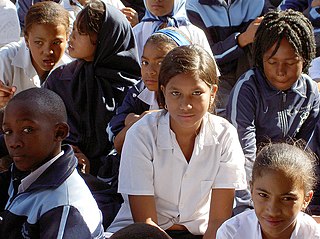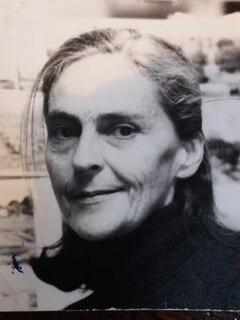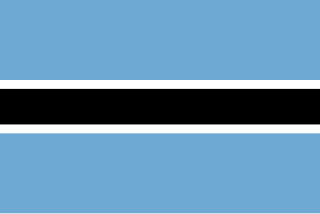
Lesotho, officially the Kingdom of Lesotho, is an enclaved country–the only one in the world outside of the Italian peninsula–within the border of South Africa. It is just over 30,000 km2 (11,583 sq mi) in size and has a population of around 2 million. Its capital and largest city is Maseru.

Malawi, officially the Republic of Malawi, is a landlocked country in southeast Africa that was formerly known as Nyasaland. It is bordered by Zambia to the northwest, Tanzania to the northeast, and Mozambique on the east, south and west. Malawi is over 118,000 km2 (45,560 sq mi) with an estimated population of 18,091,575. Lake Malawi takes up about a third of Malawi's area. Its capital is Lilongwe, which is also Malawi's largest city; the second largest is Blantyre, the third is Mzuzu and the fourth largest is its old capital Zomba. The name Malawi comes from the Maravi, an old name of the Nyanja people that inhabit the area. The country is also nicknamed "The Warm Heart of Africa" because of the friendliness of the people.
A nonprofit organization (NPO), also known as a non-business entity, not-for-profit organization, or nonprofit institution, is dedicated to furthering a particular social cause or advocating for a shared point of view. In economic terms, it is an organization that uses its surplus of the revenues to further achieve its ultimate objective, rather than distributing its income to the organization's shareholders, leaders, or members. Nonprofits are tax exempt or charitable, meaning they do not pay income tax on the money that they receive for their organization. They can operate in religious, scientific, research, or educational settings.

In the United Kingdom, independent schools are fee-paying private schools, governed by an elected board of governors and independent of many of the regulations and conditions that apply to state-funded schools. For example, pupils do not have to follow the National Curriculum. Many of the older, expensive and more exclusive schools catering for the 13–18 age-range in England and Wales are known as public schools as defined by the Public Schools Act 1868, the term "public" being derived from the fact that they were then open to pupils regardless of where they lived or their religion. Prep (preparatory) schools educate younger children up to the age of 13 to "prepare" them for entry to the public schools and other independent schools. Some former grammar schools converted to an independent fee-paying model following the 1965 Circular 10/65 which marked the end of their state funding; others converted into comprehensive schools.
Private schools, also known to many as independent schools, non-governmental, privately funded, or non-state schools, are not administered by local, state or national governments. Children who attend private schools may be there because they are dissatisfied with public schools in their area. They may be selected for their academic prowess, or prowess in other fields, or sometimes their religious background. Private schools retain the right to select their students and are funded in whole or in part by charging their students for tuition, rather than relying on mandatory taxation through public (government) funding; at some private schools students may be able to get a scholarship, lowering this tuition fee, dependent on a student's talents or abilities, need for financial aid, or tax credit scholarships that might be available. Some private schools are associated with a particular religion, such as Judaism, Roman Catholicism, or Lutheranism. For the past century, roughly one in 10 U.S families has chosen to enroll their children in private school.
An independent school is independent in its finances and governance. It is usually not dependent upon national or local government to finance its operations, nor reliant on taxpayer contributions, and is instead funded by a combination of tuition charges, donations, and in some cases the investment yield of a financial endowment. It is typically governed by a board of governors which is elected independently of government, and has a system of governance that ensures its independent operation.
A public university is a university that is publicly owned or receives significant public funds through a national or subnational government, as opposed to a private university. Whether a national university is considered public varies from one country to another, largely depending on the specific education landscape.

Bridge House School, commonly referred to as Bridge House, is situated in the Cape Winelands close to Franschhoek, Stellenbosch and Paarl, and is an independent day and boarding school for over eight hundred girls and boys from Playschool to Grade 12. Bridge House is a member of the Independent Schools Association of Southern Africa (ISASA), the International Round Square Organisation. The School motto is “Learning for Life”.

Education in South Africa is governed by two national departments, namely the department of Basic Education (DBE), which is responsible for primary and secondary schools, and the department of Higher Education and Training (DHET), which is responsible for tertiary education and vocational training. Prior to 2009, these two departments were represented in a single Department of Education.

Beaulieu College is a private, coeducational day school founded in 2000. It is located in Kyalami, Midrand, Gauteng, South Africa.

Education in Zimbabwe is under the jurisdiction of the Ministry of Primary and Secondary Education for primary and secondary education and the Ministry of Higher and Tertiary Education, Science and Technology Development for higher education. Both are regulated by the Cabinet of Zimbabwe. The education system in Zimbabwe encompasses 13 years of primary and secondary school and runs from January to December. The school year is a total of 40 weeks with three terms and a month break in-between each term.
Treverton Preparatory School and College, situated in Mooi River, South Africa, cater for boys and girls of all faiths from Grades 000 to 12 and Post-Matric. A member of the Independent Schools Association of Southern Africa (ISASA), Treverton is an inter-denominational Christian school founded on a Baptist heritage.
Student Sponsorship Programme South Africa(SSP SA) is a non-profit trust based in Johannesburg, South Africa that enables academically distinguished, economically disadvantaged students to excel at some of the top private and public high schools in the Gauteng and Eastern Cape provinces. The SSP process begins by recruiting exceptional students from underprivileged communities and placing those students into top private and public high schools of nearby districts. To complete the process and ensure a positive outcome, SSP provides extensive support services for the students and their parents throughout all the high school years.

Sinenjongo High School is a high school in Joe Slovo Park, Milnerton, Cape Town, South Africa.

SPARK Schools is an independent school network in South Africa. SPARK Schools was founded by Stacey Brewer and Ryan Harrison in 2012. Their schools use a blended learning model with adaptive software and individualised learning to accelerate learning and increase student achievement. SPARK Schools uses a hybrid funding model, having attracted funding from both non-profit foundations focused on high impact philanthropy and from for-profit impact investors.
The Southern African Institute of Steel Construction (SAISC) is an organization which helps building and construction in South Africa by serving to promote and develop companies providing steel-related products and services to the industry.
Langa Education Assistance Program (LEAP), also known as LEAP Science and Maths Schools, is a collection of six non-fee payment secondary education schools located in three provinces in South Africa. The first LEAP school opened in 2004 in rented premises in Observatory, Cape Town and served mainly, learners from the township of Langa. As an independent school, LEAP is mainly founded by South African Corporates with limited subsidies from the Department of Basic Education.
St. Nicholas Diocesan School is a diocesan Anglican school, located in Pietermaritzburg, Kwa-Zulu Natal, South Africa. St. Nicholas is an independent school catering for boys and girls in Grades RR to 12, and is a member of the Independent Schools Association of Southern Africa.
Japari School is an independent pre-preparatory and preparatory primary school located in Johannesburg, South Africa. It aims to serve learners from Grade 0 / R to Grade 7 who experience difficulty learning in mainstream channels.

Sonia Machanick was a South African medical doctor, author and educational psychologist who pioneered new methods of teaching children with dyslexia and other learning difficulties. She founded Japari School, a special school in Johannesburg that provides education for children who struggle to thrive in the mainstream education system. She wrote a series of four graded reading books and other reading tutors in English and Afrikaans that were widely used throughout the 1960s and 1970s for teaching the phonics reading method, as well as articles concerning the treatment of children with learning difficulties.













